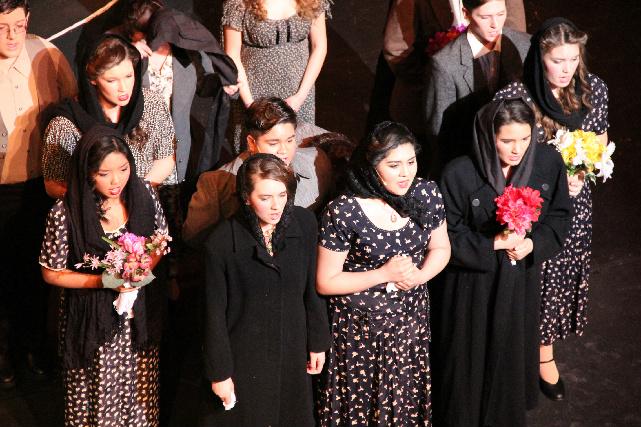‘Evita’ mesmerizes with intriguing musical performances
“PERÓN! PERÓN! PERÓN!” The chant reverberated in my head long after the school’s spring production, “Evita,” was over, prompting me to spend the next hour sitting on my couch, googling all there is to know about Eva Duarte de Perón.
“Evita” chronicles the early life, rise to power and eventual death of the Spiritual Leader of Argentina, Eva Perón. Although despised and criticized by the wealthy bureaucrats of Argentina, Perón was widely revered by the descamisados, “shirtless ones,” for her charity and philanthropy work towards the poor. She is sort of like Argentina’s Susan B. Anthony, as she was a staunch women’s suffrage advocate.
I learned all this from sitting in my seat 10 minutes before the show started. There was a slideshow of Eva Perón’s pictures followed by various quotes of hers projected onto a white screen pasted on stage. I was intrigued, and immediately pulled out my phone to search more about this woman, hopefully enough to understand the play even further. Looking up at the stage a split second before the dimming lights commenced the show, I noticed the Argentinian flag displayed on both sides of the stage. A nice touch, I thought, to emphasize the setting of this play.
If feelings can take the place of thoughts, then “chills” is all I thought. The train of words traveling through my head hit a bomb and exploded as soon as the chorus mourned Evita’s death with the sepulchral hymn, “Requiem for Evita.” Immediately, the cold, involuntary sensation filled me up head to toe and all I could think of was how chilling this was. It only continued from there.
As far as I’m concerned, the stars of the show were Migaldi (Jonah Petty) and of course, Eva Perón (Casey Borghesi). As soon as Petty belted out “Night of a Thousand Stars,” my ears were seduced. His singing is flawless, the depth and feeling in his voice touched my soul. He was a mini Michael Bublé, with his 40s-esque hairdo and suit in this contemporary world. Borghesi, however, is quite possibly the sole reason I sat through the whole show. I was pretty much waiting for her to beautifully serenade the audience with lyrics depicting Eva Perón’s plight the whole time. I’m no expert on singing, but the notes she hit and fluttered through resonated very smoothly with me. Her voice is the essence of ear candy.
The acting itself was nothing spectacular; it was as usually would be expected with a talented school-play cast. By no means was I blown away by it, but the performance was commendable, don’t get me wrong. If anything was extraordinary, however, it was facial expressions. With Borghesi, Petty, anyone in the chorus — the facial expressions were as accurate to any emotion depicted in the musical as it could be. I really knew who was sad, angry and elated. I knew who was frustrated, contemplating or even about to roll their eyes.
The costumes were a visual treat. It was impeccably 1940s. All the girls looked adorable with floral printed dresses and the modestly-heighted black heeled shoes iconic of the time period.
I left the theater far more curious about Eva Perón, and even more in love with 1940s fashion. The only real flaw with the play was not being able to understand some of the dialogue. Nothing was spoken, it was all sung, so depending on the tempo I couldn’t understand anything at all. It is hard to figure out what is going on at times, unless one knows Eva Perón’s story.
Google Eva Perón, and then come see the show. It is well worth your time and the music is more than a pleasure to sit through. The play runs from March 6 through 8 at 7 p.m., with a matinee showing on March 8 at 2 p.m. Tickets are $12 regular admission, and $8 with an ASB card.
by KAVLEEN SINGH







![On the stage, Daniel Bozinovski and Rachel Treto play their part as Tom and Hannah in the show “The Cast List”. The show was about a group of students who were told about their cast list for the play “Romeo and Juliet.” The Theater I students were in preparation for their first showcase of the year. Students went over their lines during all of their class for the past two months. “[We put in] a lot of rehearsal, practicing lines, making sure you have everything memorized and making sure you are ready to go in and not forget anything,” Nathan Weeks said. Photo by Megan Kubas.](https://www.whitneyupdate.com/wp-content/uploads/2024/05/IMG_4085-600x396.jpg)
